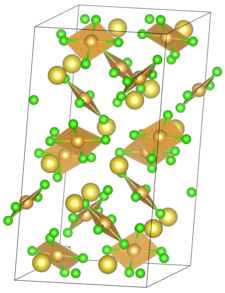Chemistry:Sodium tetrachloroaurate
 | |
| Names | |
|---|---|
| IUPAC name
Sodium tetrachloroaurate (III)
| |
| Other names
Sodium gold chloride, yellow gold chloride
| |
| Identifiers | |
3D model (JSmol)
|
|
| ChemSpider | |
| EC Number |
|
PubChem CID
|
|
| UNII | |
| |
| |
| Properties | |
| NaAuCl4 | |
| Molar mass | 361.756 g/mol |
| Appearance | Orange powder |
| Density | 3.81 g cm−3[2] |
| anhydrous: 139g/100ml (10°C) 151g/100ml (20°C) 900g/100ml (60°C) [3] | |
| Solubility | Sparingly soluble in diethyl ether,[4] soluble in alcohol, ether [3] |
| Hazards[5] | |
| GHS pictograms |  
|
| GHS Signal word | Danger |
| H315, H319, H335 | |
| P261, P264, P271, P280, P302+352, P332+313, P305+351+338, P337+313, P304+340, P312, P330, P333+313, P363, P403+233, P405, P501 | |
Except where otherwise noted, data are given for materials in their standard state (at 25 °C [77 °F], 100 kPa). | |
| Infobox references | |
Sodium tetrachloroaurate is an inorganic compound with the chemical formula NaAuCl4. It is composed of the ions Na+ and AuCl4−. It exists in the anhydrous and dihydrate states. At room temperature, it exists as a golden-orange solid. The anhydrous and dihydrate forms are available commercially.[1]
Preparation
The conventional method of preparation of sodium tetrachloroaurate involves the addition of tetrachloroauric acid solution to sodium chloride or sodium carbonate to form a mixture. The mixture is stirred at 100 °C, and then subjected to evaporation, cooling, crystallization, and drying to obtain the orange crystals of sodium tetrachloroaurate.[4][6]
- H[AuCl
4] + NaCl → Na[AuCl
4] + HCl
- 2 H[AuCl
4] + Na
2CO
3 → 2 Na[AuCl
4] + H
2O + CO
2
However, more efficient preparation methods have been discovered recently. These are the addition of gold with sodium oxy-halogen salts and hydrochloric acid.[6]
Uses
It is used in a wide range of applications. For example, it is used as a catalyst for the hydrochlorination of acetylene, or the oxidation of sulfides.[4]
References
- ↑ 1.0 1.1 PubChem. "Sodium tetrachloroaurate" (in en). https://pubchem.ncbi.nlm.nih.gov/compound/27127.
- ↑ Jones, P. G.; Hohbein, R.; Schwarzmann, E. (1988-07-15). "Anhydrous sodium tetrachloroaurate(III)". Acta Crystallographica Section C Crystal Structure Communications (International Union of Crystallography (IUCr)) 44 (7): 1164–1166. doi:10.1107/s0108270188002756. ISSN 0108-2701. Bibcode: 1988AcCrC..44.1164J.
- ↑ 3.0 3.1 Perry, Dale L. (2011). Handbook of Inorganic Compounds. CRC Press; 2 edition (May 18, 2011). pp. 380. ISBN 9781439814611.
- ↑ 4.0 4.1 4.2 Westcott, Stephen A. (2001), "Sodium Tetrachloroaurate(III)" (in en), Encyclopedia of Reagents for Organic Synthesis, American Cancer Society, doi:10.1002/047084289x.rs108, ISBN 9780470842898
- ↑ "Sodium Tetrachloroaurate". https://www.espimetals.com/index.php/msds/276-sodium-tetrachloroaurate.
- ↑ 6.0 6.1 Lu, Lin; Chen-Hsiang Wang & Kuei-Sheng Fan et al., "Method of making inorganic gold compound", US patent 10046976, published 2018-08-14, assigned to Tripod Technology Corp.
 |

